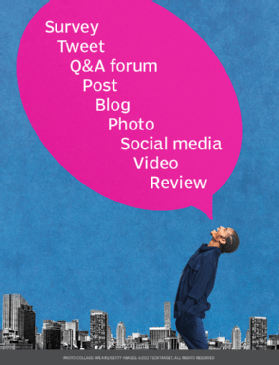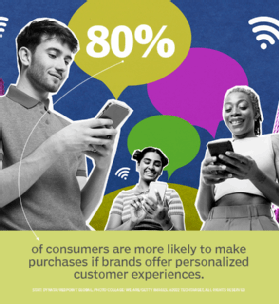What is user-generated content and why is it important?
What is user-generated content?
User-generated content (UGC) is published information that an unpaid contributor provides to a website. The information might be a photo, video, blog or discussion forum post, poll response or comment made through a social media website.
In traditional communication methods, a single source provides information to multiple receivers -- such as a commercial on a local news channel, a newspaper article or a book. However, some media organizations base their entire business models on UGC, encouraging unpaid contributors to provide content that the media organization can republish, promote and profit from.
Why is user-generated content important?
With the rise in social networking channels, user-generated and organic-reach content has become more popular than ever. Customers and brand loyalists mainly generate this brand-specific content, which is vital in influencing the buyer's journey.
The following highlights how UGC can be beneficial if incorporated into a company's marketing mix:
- Authenticity. In a competitive online space, brands can benefit from authentic reviews, sentiments and attention that their customers generate. UGC can also boost social media reach and growth, as most buyers are willing to accept recommendations for products and services if real people make them as opposed to the brand itself. For example, with the release of the iPhone 6, Apple encouraged users to take everyday photos from their phones and upload them using the hashtag #ShotOniPhone6. Apple picked the best images and showcased them on various print and digital media platforms worldwide, which yielded rave reviews and affirmation for the product.
- Brand loyalty. UGC cultivates brand loyalty because consumers create the content rather than official representatives of the brand. Companies can gain a high level of customer faith by putting their audience first and encouraging them to participate in the brand's image building.
- Cost-effectiveness. UGC is a cost-effective option for businesses looking to promote their brands without spending thousands of dollars on promotions and TV commercials. Unpaid customers -- who are trying to share their experience with a product or service, build a connection with like-minded individuals or are simply looking to avail some perks – create most UGC content organically.
- SEO boost. Positive customer reviews and surveys can elevate a brand's search engine optimization (SEO) Consumers mainly post UGC on blogs with backlinks to product websites. Analyzing consumers' search keywords and phrases enables brands to improve their keyword optimization research.
While UGC has many benefits, it can also have a few drawbacks. Commercial media's growing reliance on user-generated content has led to controversy in the publishing world. Some organizations monitor UGC carefully for profanities, lies and attacks on other contributors. Other organizations let users self-police their content.
Types of user-generated content
UGC isn't limited to a company's size, industry affiliation or product offerings. From luxury brands to household products, user-generated content can resonate with all audiences.

The following are the main types of user-generated content:
- Images. Unpaid customer images of products posted on social media, blogs and other online platforms.
- Videos and live streams. GoPro videos, YouTube videos, Instagram Stories, natively shot videos, live video streams on Facebook and other platforms, which the creator isn't getting paid for. These videos can also include product unboxing and hauls.
- Social media content. Any social media message regarding a brand, such as a tweet, Instagram post or Facebook update.
- Product reviews and testimonials. Customer reviews on a section of a product's website or a third-party site, which can include Yelp, Google, TripAdvisor and G2.
- Blog posts. A product tutorial or a review that bloggers post on their blogs without getting paid for it.
- Q&A forum. A public forum where customers and the brand can engage in healthy discussions and answer questions regarding a product.
- Case studies. Detailed, unpaid customer reviews that explain the pros and cons of products and services.
- Surveys. Customer-provided views or descriptions of a specific feature or product.
How to integrate user-generated content into your marketing strategy
A study on UGC that market research firm Dynata conducted for software provider Redpoint Global indicates that 80% of consumers are more likely to make purchases if the brands offer personalized customer experiences. This data is just one example of the importance of integrating UGC into a brand's marketing strategy.

The following are ways that companies can integrate UGC into content marketing strategy:
Reviews
Before making purchasing decisions, most consumers read product reviews because they provide a glimpse into the product they're interested in buying. Reviews also increase the reliability factor for a brand and help boost traffic to a website, which results in increased conversion rates.
To integrate review-based UGC into their marketing campaign, companies should encourage customers to leave reviews for every product they purchase. Companies should also provide customers the option to leave reviews on multiple platforms, such as Facebook, Yelp, Google, TripAdvisor and third-party websites, to facilitate conversion rates.
Another way to incorporate reviews into a marketing strategy is to incentivize them by exchanging reviews for coupons, reward points or gift cards. Emails with incentive keywords in the subject line can help motivate customers to rate products.
Businesses should also remember that reviews can be both positive and negative. However, both serve a purpose in building a brand's identity. Any negative reviews should be taken as an opportunity for a business to earn customer trust. Personally responding to every review with genuine courtesy and concern can facilitate this trust.
Hashtag contests
Hashtag contests can motivate followers to contribute to a brand's hashtag. Followers can use a specific hashtag to share content, such as photos and videos, on a social media platform to win prizes. These contests are a great option for brands that want to popularize their hashtags, as it helps with brand awareness and can help boost sales.
To incorporate this popular UGC strategy, companies should create content with hashtags that are unique and easy to remember. For example, a hotel comparison site, Trivago, launched an Instagram photo contest using the hashtag #trivagofaves. Participants had to share original photos of their favorite hotels listed on Trivago by tagging them with the given hashtag to win $500. The contest generated over 37,000 views and produced tons of posts featuring top hotels along with partner promotions.
Gamification
This incentive-based strategy makes UGC entertaining and rewarding for customers. Users are recognized and rewarded in return for completing a few tasks. Brands use concepts such as high scores, badges, leaderboards, levels and points to encourage people to complete tasks and share their experiences with the brand.
To reap the benefits of gamification, companies can grant customers points for writing social media posts. Customers can then use those points for discounts and coupons. Other options, such as receiving unlockable freebies with repeat purchases, can also be part of the incentives.
Video content
Videos can connect to customers in a unique way. Their potential for shareability and the possibility of going viral can substantially boost a business's following. Also, when people see real customers filming their shopping experiences, traveling or using certain products, it automatically instills confidence in those products and services.
Using curated content from customers, brands can create UGC videos that showcase original perspectives and genuine insights into their brands. UGC videos tend to gain higher consumer trust compared to branded videos, as they can engage the audience at a personal level.
Seasonal content
The changing seasons and holidays offer myriad opportunities for businesses to promote through UGC. During special occasions and holidays, brands can connect to their followers on an emotional level.
Businesses should study their target audience and holiday season goals to integrate seasonal UGC into their marketing strategy successfully. Brands can also ask followers to share images, post videos, use hashtags, write testimonials and participate in contests. For example, Starbucks used to launch the yearly #RedCupContest in December, where fans would share photos of their customized coffee cups on social media to get a chance to win a Starbucks gift card.
Examples of user-generated content
The following companies have successfully promoted their brands through UGC.
Coca-Cola: Share a Coke campaign
Coca-Cola launched this popular UGC campaign in 2011 when it decided to print the 150 most common male and female names on their bottles in Australia. The idea was to inspire people to share a Coke with loved ones. The idea went viral, and people started taking pictures of their personalized bottles and sharing them on social media with the #ShareaCoke hashtag. The excitement quickly snowballed into 80 more countries, turning this into the biggest UGC campaign of all time.
Belkin Lego iPhone cases
To market its brand, Belkin launched a UGC campaign targeting two prominent brands -- Lego and iPhones. In partnership with Lego, they asked people to use customizable Lego pieces to create design cases for their iPhones and then take photos. Participants posted their photos to Instagram using the hashtag #LEGOxBelkin. This was an effective UGC campaign because consumers could organically visualize how unique and trendy Belkin cases could be.
National Geographic's Wanderlust contest
Using photography-based UGC to increase brand awareness and development, National Geographic launched a Wanderlust contest in 2015. Users had to share their best nature shot using the #WanderlustContest hashtag to enter the contest. National Geographic awarded the contest winner a spectacular seven-day trip for two adults to the Yosemite National Park. This contest encouraged more people to go outdoors and also boosted the engagement rates for National Geographic.
T-Mobile breakup campaign
Terminating a mobile data plan can have a few consequences, such as a high termination fee, preventing most cellular subscribers from switching. Inspired by this idea to make switching easy for consumers, T-Mobile launched a UGC campaign inviting users to submit their breakup letters detailing reasons for dumping their current cellular providers. In return, T-Mobile promised to shoulder the costs associated with switching providers. Users submitted their breakup letters through a branded app and even shared them on various social media channels. This successful UGC campaign produced about 113,000 breakup letters, 2.7 million app page views and 67 million social media impressions.
Video is a popular use case of UGC which requires extensive monitoring to prevent security problems. Learn how to efficiently monitor video-based UGC.






